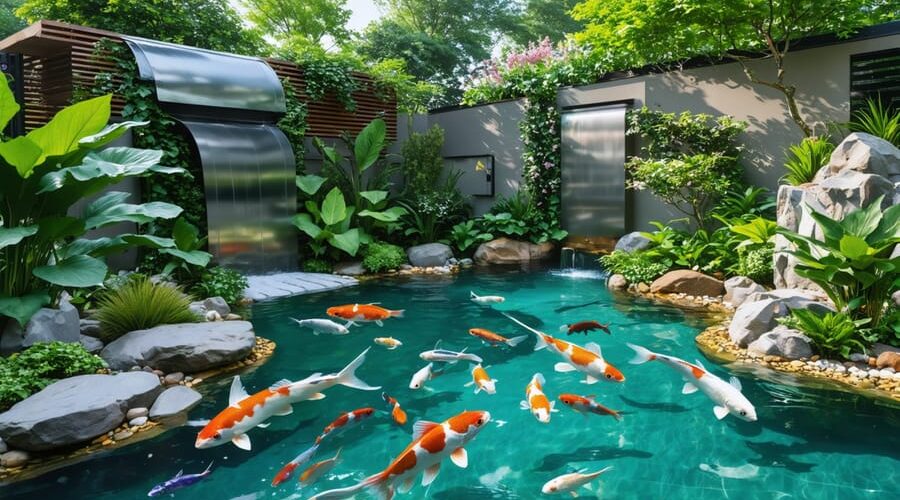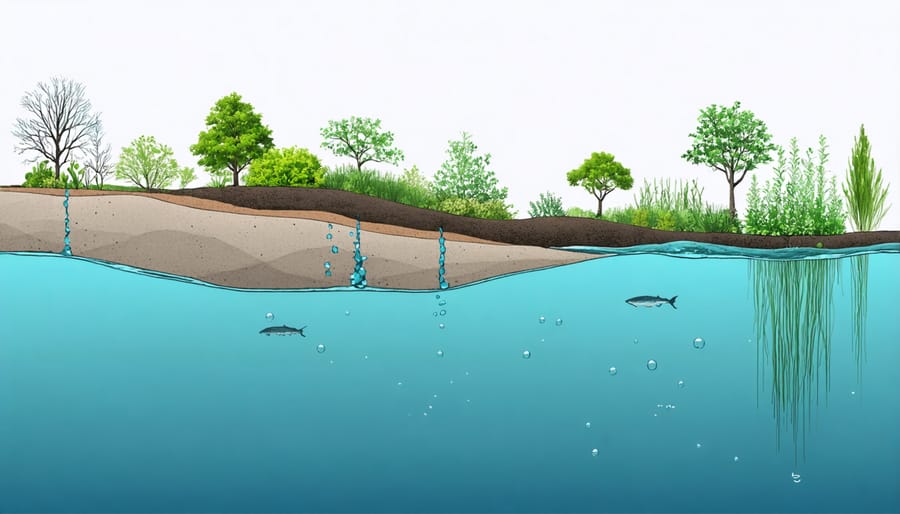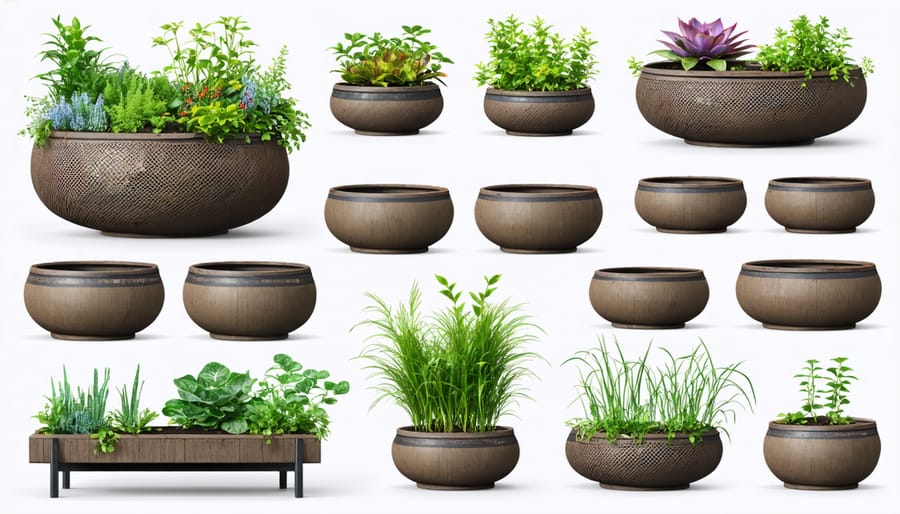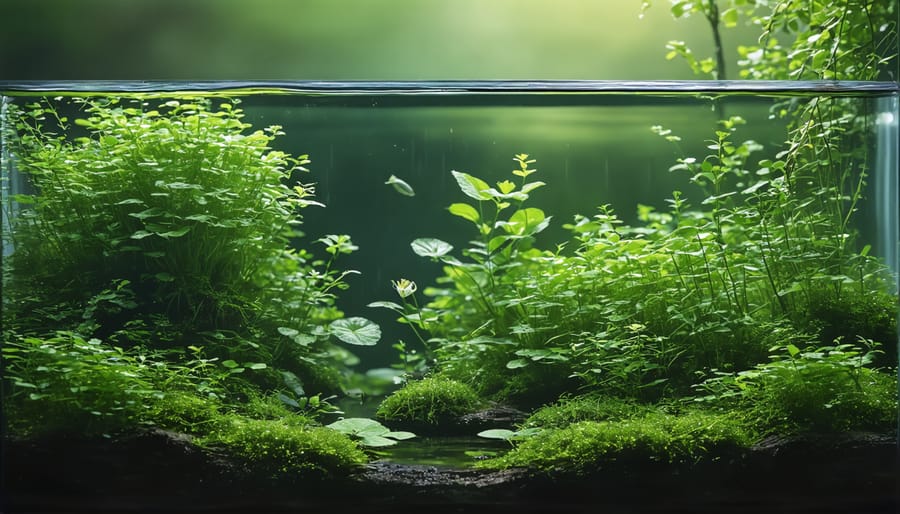
Transform Your Water Feature with Smart Aquatic Plant Systems
Transform your backyard into a thriving aquatic ecosystem by integrating smart water-efficient garden design with natural filtration systems. Aquatic water systems combine the tranquil beauty of flowing water with the practical benefits of sustainable landscaping, creating a self-sustaining environment that supports both plants and wildlife. From simple pond setups to complex water gardens, these systems work in harmony with nature to maintain water quality while reducing maintenance needs.
Whether you’re planning a small decorative fountain or a large koi pond, understanding the fundamental components of aquatic systems empowers you to create a balanced ecosystem. The right combination of pumps, filters, and plant life ensures crystal-clear water while supporting beneficial bacteria and aquatic life. By incorporating proper circulation, filtration, and plant zones, you’ll establish a robust system that practically maintains itself.
Modern aquatic systems offer innovative solutions for every space and budget, making it possible to enjoy the benefits of water gardening regardless of your yard size. These systems not only enhance your outdoor living space but also contribute to local biodiversity and create a refreshing microclimate in your garden.

Understanding Aquatic Plant Zones
Marginal Plant Zones
The marginal zone is where your water garden transitions from dry land to deeper water, typically ranging from soil level to about 6 inches deep. This area creates a natural-looking edge and plays a crucial role in your pond’s ecosystem. Plants in this zone help stabilize the bank, filter water, and provide essential shelter for wildlife.
Popular marginal plants include iris, rushes, and marsh marigolds, which thrive in these shallow waters. When planting in this zone, use specially designed marginal baskets filled with aquatic compost to keep your plants secure and prevent soil from washing into the water. Position these baskets on shelves or terraces built into your pond’s edge.
For the best results, group plants of varying heights and textures together. Tall plants like cattails can provide background structure, while lower-growing specimens like water forget-me-nots create beautiful foreground interest. Remember to maintain adequate spacing between plants, as many marginal species spread vigorously over time.
These transition zones also help disguise pond liners and create a more natural-looking water feature that blends seamlessly with your surrounding landscape.
Deep Water Zones
Deep water zones are the heart of any pond or water garden, providing essential habitat for both submerged and floating aquatic plants. These areas typically range from 2 to 4 feet deep, creating the perfect environment for stunning water lilies and other deep-water favorites.
When designing your deep water zone, consider adding planting shelves at different depths. A typical setup includes platforms at 12 inches, 18 inches, and 24 inches below the water surface. This tiered approach allows you to grow a variety of plants with different depth requirements. Water lilies, for example, thrive when their crowns are planted 18-24 inches below the surface.
Submerged plants like anacharis and hornwort play a crucial role in maintaining water quality by absorbing excess nutrients and providing oxygen. Place these plants directly on the pond bottom or in weighted containers. For floating plants like water hyacinth and water lettuce, simply let them drift freely on the surface – they’ll help shade the water and reduce algae growth.
To keep your plants healthy, use sturdy aquatic planting baskets filled with heavy clay-based pond soil. Avoid regular garden soil, which can cloud your water and create problems. Top your planted baskets with a layer of gravel to prevent soil from floating away and to give a finished look to your underwater garden.
Essential Plant Integration Tools
Planting Baskets and Containers
When it comes to adding plants to your water feature, choosing the right container makes all the difference. Mesh baskets are the most popular choice, offering excellent water flow and root development while keeping your aquatic plants securely in place. These containers come in various sizes, from small 4-inch pots perfect for marginal plants to larger 2-gallon baskets ideal for water lilies.
Solid plastic containers work well for bog plants and marginals that need more soil stability. They’re particularly useful in areas where you want to control water flow and nutrient distribution. For a natural look, try fabric planting pockets, which conform to rock arrangements and create seamless transitions between different areas of your water feature.
When selecting containers, consider depth requirements. Deep baskets (8-12 inches) are essential for water lilies and other deep-water plants, while shallow containers (4-6 inches) work well for most marginal plants. Square baskets fit neatly against pond walls, while round containers are versatile for any location.
Don’t forget about floating planters for surface plants like water lettuce or water hyacinth. These specialized containers keep plants contained while allowing them to drift naturally on the water’s surface. For smaller water features, hanging baskets modified with additional drainage holes can create attractive waterfall plantings.
Remember to line your containers with burlap or landscape fabric to prevent soil from washing away while allowing proper root growth and water circulation.

Substrate Systems
Choosing the right growing medium for your aquatic plants is crucial for their health and success. The most common substrate options each offer unique benefits for different types of water gardens.
Gravel is a popular choice for both pond bottoms and plant containers. Small to medium-sized gravel (1/4 to 3/4 inch) provides excellent root anchoring and allows beneficial bacteria to thrive. It’s particularly effective for shallow-water plants and creates a natural-looking environment.
Garden loam mixed with a bit of clay works wonderfully for heavy-feeding aquatic plants like water lilies. This rich mixture provides essential nutrients and helps anchor plants securely. Just remember to top it with a layer of gravel to prevent soil from clouding your water.
Expanded clay pellets are fantastic for filter boxes and growing beds in aquaponics systems. They’re lightweight, provide excellent drainage, and won’t break down over time. Plus, their porous nature creates an ideal environment for beneficial bacteria.
For container water gardens, specially formulated aquatic soil mixes offer the perfect balance of nutrients and stability. These pre-made options are convenient and reduce the risk of water contamination.
Sand can be used for smaller aquatic plants and ground covers. While it compacts more than gravel, it’s excellent for creating natural-looking shallow areas and works well for delicate root systems.
Remember to avoid regular potting soil, as it contains organic matter that will float and decompose, potentially harming your water quality.
Plant Anchoring Solutions
Natural Anchoring Methods
When it comes to securing aquatic plants in your water feature, natural anchoring methods offer both practical and aesthetic benefits, working harmoniously with natural water treatment methods. Rocks and gravel provide an excellent foundation for your aquatic plants, creating a stable environment that mimics their natural habitat.
Start by selecting a mix of different-sized rocks, from larger stones (2-4 inches) for primary anchoring to smaller gravel (½-1 inch) for filling gaps. Place larger rocks around the base of your plants to prevent them from floating or tipping over. The weight of the rocks helps keep root systems secure while allowing them to grow naturally through the spaces between stones.
For shallow-water plants, create graduated shelves using rocks of decreasing size, which provides different depth zones for various plant species. Cover the rocks with a layer of aquatic planting gravel to give roots something to grip onto and prevent soil from clouding the water.
Remember to avoid sharp-edged rocks that could damage plant roots or pond liners. For best results, rinse all rocks and gravel thoroughly before placing them in your water feature to remove any dust or debris that could affect water clarity.
Artificial Anchoring Systems
When it comes to securing aquatic plants in your water feature, modern artificial anchoring systems offer practical and reliable solutions that look natural while keeping your plants exactly where you want them. These innovative systems range from simple weighted bases to sophisticated floating platforms designed specifically for water gardens.
Mesh plant baskets are among the most popular anchoring options, featuring a sturdy design with plenty of holes for water circulation and root growth. These baskets can be filled with aquatic soil and topped with gravel to prevent soil dispersion while keeping plants firmly in place. For floating plants, specialized ring anchors provide stability while allowing natural movement with water flow.
Another excellent option is the modular floating island system, which creates dedicated growing spaces that can be easily repositioned. These platforms are particularly useful for larger water features and can support multiple plants while providing essential wildlife habitat.
For those seeking a more natural look, synthetic rock formations with built-in planting pockets offer both aesthetic appeal and functionality. These artificial rocks blend seamlessly with your landscape while providing secure anchoring points for various aquatic plants.
Remember to choose anchoring systems that match your plants’ specific needs and your water feature’s size. The right system will ensure your aquatic garden thrives while maintaining its designed appearance.
Maintenance Tools and Techniques

Pruning and Cleaning Tools
Keeping your aquatic plants well-maintained requires the right tools for the job. A quality pair of pruning shears is essential – look for stainless steel ones that resist rust and corrosion from constant water exposure. These will help you trim dead leaves and control plant growth without damaging healthy tissue.
A long-handled rake is invaluable for removing fallen leaves and debris from your water feature. Choose one with adjustable length to reach different depths comfortably. Some rakes come with interchangeable heads, giving you options for different cleaning tasks.
Don’t forget about your skimming net – it’s perfect for daily maintenance and catching floating debris before it sinks. Get one with fine mesh for smaller particles and a sturdy frame that won’t bend under use. Having both a shallow and deep net gives you more versatility in maintenance.
For those stubborn algae spots, keep a selection of scrub brushes handy. Soft-bristled brushes work well for delicate surfaces, while stiffer ones tackle tough buildup on rocks and hardscape features. Extension poles allow you to reach deeper areas without getting wet.
Plant scissors with curved blades make precise cuts under water, especially useful for trimming submerged plants. These specialized tools help maintain clean cuts that prevent disease and promote healthy growth.
Store your tools in a dedicated container near your water feature, and always clean them after use to prevent rust and cross-contamination. A quick rinse and dry will extend their life and keep your aquatic garden looking its best.
Water Quality Management
Successful water gardening starts with understanding how to maintain healthy water conditions for your aquatic plants and fish. The key to maintaining crystal clear water lies in having the right tools and knowing how to use them effectively.
A reliable water testing kit is your first line of defense, helping you monitor essential parameters like ammonia, nitrites, and nitrates. These kits typically come with color-coded charts that make it easy to interpret results, even if you’re new to water gardening. Regular testing helps you catch potential problems before they affect your aquatic ecosystem.
Achieving an optimal water pH balance is crucial for plant and fish health. Most aquatic plants thrive in slightly acidic to neutral conditions (pH 6.5-7.5). Keep pH adjusters on hand to make necessary corrections when levels drift outside the ideal range.
Water conditioners are another essential tool, helping to neutralize harmful chlorine and heavy metals found in tap water. When adding fresh water to your system, always treat it first to create a safe environment for your aquatic life.
For larger systems, consider investing in an automatic dosing system that can maintain consistent water parameters with minimal intervention. These systems are especially helpful for busy gardeners who can’t always monitor their water features daily.
Remember to keep a maintenance calendar to track testing schedules, water changes, and filter cleaning. This simple organizational tool can make the difference between a thriving aquatic garden and one that struggles to maintain balance.
As we’ve explored throughout this article, integrating aquatic plants into your water feature isn’t just about creating a beautiful display – it’s about establishing a thriving ecosystem that brings life and balance to your outdoor space. From selecting the right filtration systems to choosing appropriate plant varieties, each element plays a crucial role in creating a successful aquatic environment.
Remember that starting small is perfectly fine. You might begin with a few hardy floating plants before gradually expanding to more diverse species. The key is to maintain patience and observe how your system responds to different additions and changes.
The rewards of a well-planned aquatic plant system are truly worth the effort. Beyond the stunning visual appeal, you’ll enjoy improved water quality, reduced maintenance needs, and the joy of watching your aquatic garden flourish throughout the seasons. Wildlife like birds, butterflies, and beneficial insects will soon discover your water feature, adding another layer of natural wonder to your space.
Whether you’re working with a small container water garden or a large pond, the principles we’ve discussed will help guide you toward success. Don’t be afraid to experiment and learn from both achievements and setbacks – they’re all part of the journey.
Ready to start your aquatic gardening adventure? Begin by assessing your current setup, gathering the necessary supplies, and implementing these strategies one step at a time. Your perfect water garden awaits!
